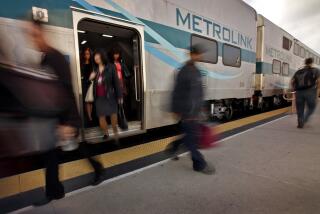New train safety improvements urged
- Share via
Metrolink should add a second engineer to its locomotives, install anti-collision technology and place an additional video camera in the cab of its engines to monitor train drivers, according to a motion supported by several Los Angeles city and county officials.
The improvements, however, are not being sought by Metrolink. Instead, the motion will be considered today at a board meeting of the Los Angeles County Metropolitan Transportation Authority -- one of the five county transit agencies that funds and oversees Metrolink. It remains far from clear whether the Metrolink board of directors will follow suit with the MTA’s recommendations. Metrolink spokesman Francisco Oaxaca declined comment Wednesday night on the MTA motion.
The safety measures are being pushed in the wake of the Sept. 12 head-on collision in Chatsworth between a freight train and Ventura County-bound Metrolink train that killed 24 passengers and the Metrolink engineer. Another 135 passengers were injured.
The MTA is the largest of the five agencies that oversee Metrolink. It also provides the most money to Metrolink. The motion is being pushed by Los Angeles Mayor Antonio Villaraigosa and county Supervisors Mike Antonovich and Don Knabe. Richard Katz, the former assemblyman who was appointed last week by Villaraigosa to the Metrolink board, is also championing the measure.
The motion, which would provide $5 million to help pay for the upgrades, is expected to receive wide support.
Perhaps the most high-profile aspect of the MTA motion is its call for Metrolink to quickly install an older technology that can set a train’s brakes if it doesn’t stop at a red signal.
The only stretch of track that Metrolink uses with such safeguards is in south Orange County. On Wednesday, the House of Representatives approved a rail safety bill that would require more sophisticated anti-collision devices -- known as positive train control -- to be installed on passenger trains by 2014. The Federal Railroad Administration has been pushing the newer systems, which officials say would be more effective.
But Richard Katz, a member of the MTA and Metrolink boards, said that Metrolink needs to act more quickly. “I want people safe on the trains we run,” he said. “I don’t want to wait for a system that takes into account every variable in the United States of America.”
The MTA motion also directs the contractor that runs Metrolink’s trains -- Veolia Transportation -- to add a second engineer to all locomotives. Metrolink runs about 145 trains each weekday, with many engineers working split shifts that equate to 15-hour workdays. Union officials who represent engineers could not be reached Wednesday night, and it wasn’t clear that Metrolink had that many engineers available. Still, Ron Roberts, Metrolink’s board chairman, told a U.S. Senate committee Tuesday that the agency had begun discussing whether two engineers were needed.
Still, fitting two engineers into Metrolink’s cab cars could prove difficult. The cab cars are passenger coaches equipped with an engineer’s booth in the front. They are used when the train is pushed from behind by a locomotive, a standard practice on the nation’s commuter railroads.
--
Times staff writer Dan Weikel contributed to this report.
More to Read
Sign up for Essential California
The most important California stories and recommendations in your inbox every morning.
You may occasionally receive promotional content from the Los Angeles Times.










